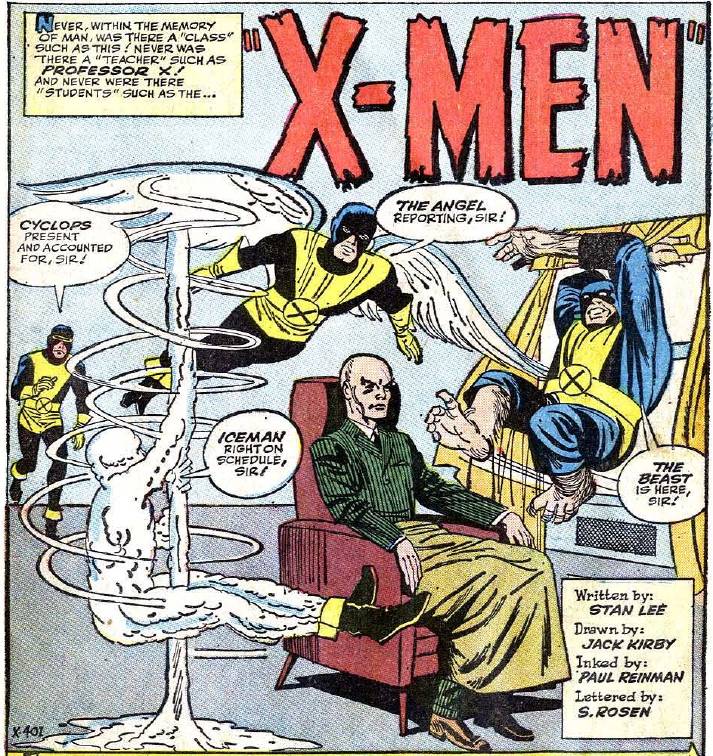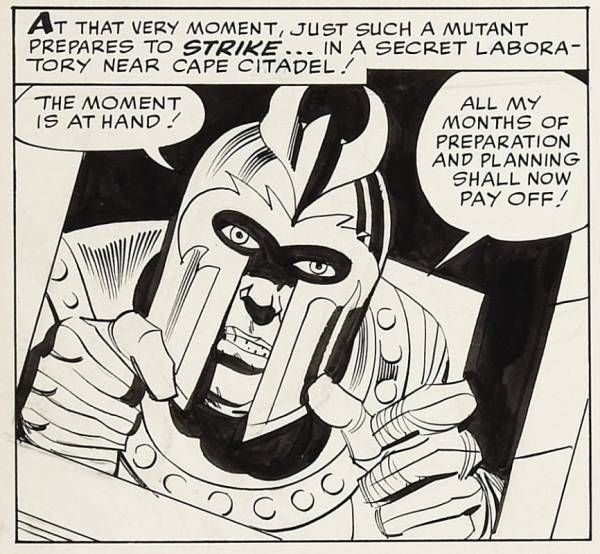X-MEN #1 (1963) :
Suite au succès des titres lancés au cours des précédentes années, Martin Goodman a été en mesure en 1963 de renégocier son contract avec son distributeur Independant News (affilié à DC), dans l’optique de se voir autoriser la publication d’un petit nombre de séries supplémentaires (leur rangs continueront à augmenter à partir de 1968, permettant à certains héros de faire enfin « chambre à part » dans leurs propres séries). Avengers #1 & X-Men #1 (sortis le même jour) font partie de cette vague.

Tom Brevoort : « X-MEN was one of two titles originated at the behest of publisher Martin Goodman. (DAREDEVIL was the other one.) An old-time pulp publisher, Martin would typically flood the marketplace with knock-offs of any successful magazine, and turn a quick profit. In the case of X-MEN, he told Stan that what he wanted was another FANTASTIC FOUR. And at least on the surface, that’s very much what Stan and Jack gave him. The identical costumes, the familiar personality types, even the villain was reminiscent of the FF’s premiere bad guy. But there’s a different idea buried at the heart of it, a concept that Kirby would return to again and again–the notion of the “hidden race living among us, with members both good and evil.”
À la demande de Goodman (lorgner sur les précédents succès que sont Spidey & les FF, ce qui déboucha donc sur Daredevil et les X-Men), Lee/Kirby ont produit une nouvelle série dont les similitudes de surface évoquent effectivement la first family (ainsi que la Doom Patrol d’en face, apparue à peu près au même moment). Soit un groupe de super-héros aux costumes identiques, composé d’une contrepartie de la Torche (Iceman/Iceberg) et d’un musclor simiesque à la manière de la Chose (le Fauve), de même qu’un sinistre adversaire rappelant un peu Fatalis en terme de look (plus le couple en devenir Scott/Jean et le rôle de fondateur/mentor/patriarche, dévolu à Charles Xavier/Professor X aka le sosie de Yul Brynner).
Stan Lee (Wizard: X-Men Turn Thirty) : “As with all superhero teams, I had to have an excuse for putting them together. “The Fantastic Four were essentially a family, the Avengers were a club. What could the X-Men be that would be different ? (…) I figured if they’re teenagers, what’s more natural than a school ?”
En phase avec l’air du temps (la lutte pour les droits civiques aux USA) et surtout les précédents jalons en terme d’héros adolescents (Peter Parker, Johnny Storm, etc), le concept de la série (la « mutanité ») permet à Stan Lee de ne pas avoir à se fouler pour trouver des justifications pseudo-scientifiques concernant l’acquisition de super-pouvoirs (« The Mutants » a même été un titre brièvement envisagé).

Stan Lee (Comics Creators On X-Men) : “I always wanted Magneto to turn out to be Professor X’s brother. If I had stayed with the book, that’s what I would have done. (…) I figured that I could come up with an explanation when I needed it: I always did. But I thought it would be fun if Professor Xavier and Magneto were brothers.”
Quant à Magnéto dans sa version originelle (résolument manichéenne, la version nettement plus nuancée de Chris Claremont étant encore loin), il constitue un adversaire plutôt charismatique sur lequel la série va beaucoup (trop ?) se reposer, tel Loki pour Journey Into Mystery ou Mordo pour Strange Tales. Il aura cependant fallu attendre la fin de la décennie pour qu’il dévoile son faciès et surtout la couleur de ses cheveux chez Thomas/Adams (le premier zénith qualitatif des X-Men durant ces années pré-Claremont).
Stan Lee (Wizard: X-Men Turn Thirty) : “I thought magnetism was a great power because there was so much I could do with it. Somebody points a gun at him and he gestures and the barrel bends. We figured out a way he could walk in the air. I like villains who are more than one-dimensional: He didn’t think of himself as a villain. On the other hand, he did call his group “The Brotherhood of Evil Mutants”. We were kind of corny in those days.”
Si certains éléments cruciaux sont encore absents (le passif pour Xavier/Magnéto, la romance pour Scott/Jean, l’amitié pour Hank/Bobby), d’autres sont déjà là, qu’il s’agisse des séances d’entraînement (avant la création de la salle des dangers), ou encore des costumes assortis (remis au goût du jour par la génération de Kitty Pryde puis plus tard le run de Grant Morrison, mais ça c’est une autre histoire…).
